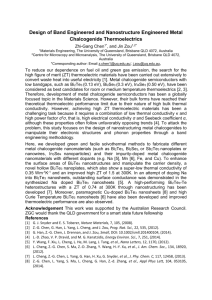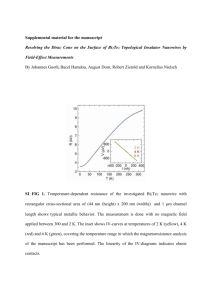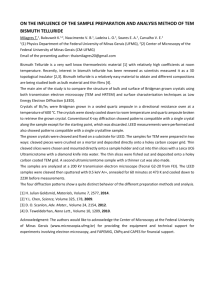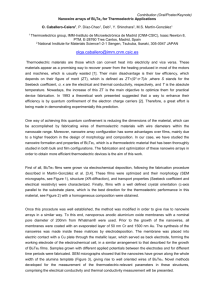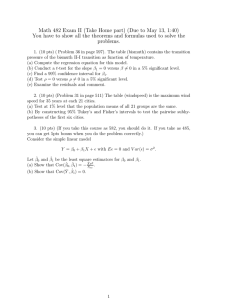Structural Properties of Zn Bi Te alloys
advertisement
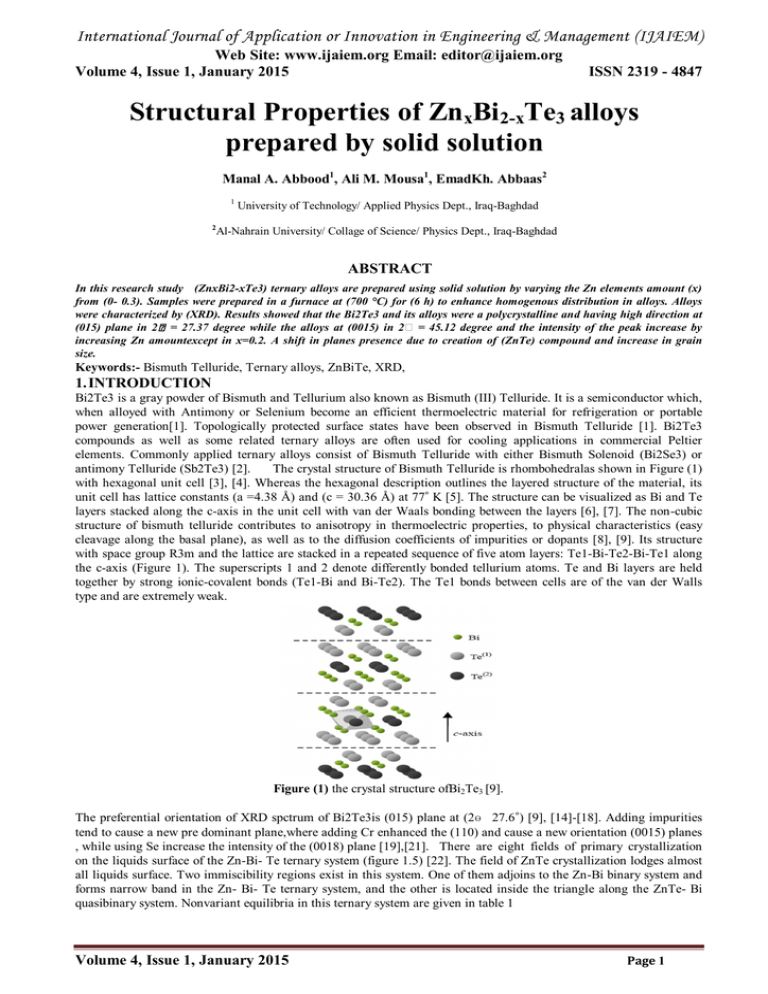
International Journal of Application or Innovation in Engineering & Management (IJAIEM) Web Site: www.ijaiem.org Email: editor@ijaiem.org Volume 4, Issue 1, January 2015 ISSN 2319 - 4847 Structural Properties of ZnxBi2-xTe3 alloys prepared by solid solution Manal A. Abbood1, Ali M. Mousa1, EmadKh. Abbaas2 1 2 University of Technology/ Applied Physics Dept., Iraq-Baghdad Al-Nahrain University/ Collage of Science/ Physics Dept., Iraq-Baghdad ABSTRACT In this research study (ZnxBi2-xTe3) ternary alloys are prepared using solid solution by varying the Zn elements amount (x) from (0- 0.3). Samples were prepared in a furnace at (700 °C) for (6 h) to enhance homogenous distribution in alloys. Alloys were characterized by (XRD). Results showed that the Bi2Te3 and its alloys were a polycrystalline and having high direction at (015) plane in 2 = 27.37 degree while the alloys at (0015) in 2 = 45.12 degree and the intensity of the peak increase by increasing Zn amountexcept in x=0.2. A shift in planes presence due to creation of (ZnTe) compound and increase in grain size. Keywords:- Bismuth Telluride, Ternary alloys, ZnBiTe, XRD, 1. INTRODUCTION Bi2Te3 is a gray powder of Bismuth and Tellurium also known as Bismuth (III) Telluride. It is a semiconductor which, when alloyed with Antimony or Selenium become an efficient thermoelectric material for refrigeration or portable power generation[1]. Topologically protected surface states have been observed in Bismuth Telluride [1]. Bi2Te3 compounds as well as some related ternary alloys are often used for cooling applications in commercial Peltier elements. Commonly applied ternary alloys consist of Bismuth Telluride with either Bismuth Solenoid (Bi2Se3) or antimony Telluride (Sb2Te3) [2]. The crystal structure of Bismuth Telluride is rhombohedralas shown in Figure (1) with hexagonal unit cell [3], [4]. Whereas the hexagonal description outlines the layered structure of the material, its unit cell has lattice constants (a =4.38 Å) and (c = 30.36 Å) at 77 ͦ K [5]. The structure can be visualized as Bi and Te layers stacked along the c-axis in the unit cell with van der Waals bonding between the layers [6], [7]. The non-cubic structure of bismuth telluride contributes to anisotropy in thermoelectric properties, to physical characteristics (easy cleavage along the basal plane), as well as to the diffusion coefficients of impurities or dopants [8], [9]. Its structure with space group R3m and the lattice are stacked in a repeated sequence of five atom layers: Te1-Bi-Te2-Bi-Te1 along the c-axis (Figure 1). The superscripts 1 and 2 denote differently bonded tellurium atoms. Te and Bi layers are held together by strong ionic-covalent bonds (Te1-Bi and Bi-Te2). The Te1 bonds between cells are of the van der Walls type and are extremely weak. Figure (1) the crystal structure ofBi2Te3 [9]. The preferential orientation of XRD spctrum of Bi2Te3is (015) plane at (2ɵ 27.6 ͦ) [9], [14]-[18]. Adding impurities tend to cause a new pre dominant plane,where adding Cr enhanced the (110) and cause a new orientation (0015) planes , while using Se increase the intensity of the (0018) plane [19],[21]. There are eight fields of primary crystallization on the liquids surface of the Zn-Bi- Te ternary system (figure 1.5) [22]. The field of ZnTe crystallization lodges almost all liquids surface. Two immiscibility regions exist in this system. One of them adjoins to the Zn-Bi binary system and forms narrow band in the Zn- Bi- Te ternary system, and the other is located inside the triangle along the ZnTe- Bi quasibinary system. Nonvariant equilibria in this ternary system are given in table 1 Volume 4, Issue 1, January 2015 Page 1 International Journal of Application or Innovation in Engineering & Management (IJAIEM) Web Site: www.ijaiem.org Email: editor@ijaiem.org Volume 4, Issue 1, January 2015 ISSN 2319 - 4847 Table 1 The Nonvariant equilibria in ternary system 2. PROCEDURE Bi2Te3 and ZnxBi2-xTe3 targets were prepared in this work by take the ratio (2:3) of atomic weight for Bismuth (99.999%) to Tellurium (99.99%) with small portions of Zinc (99.999%) all materials were purchase from Aldrich. By charging a mixing of an accurate amount of Zinc, Bismuth and Tellurium powder in an evocated quartz tube then putted in a furnace at (700 °C) for (6 h) to enhance homogenous distribution in alloys. All other targets Zn0.1Bi1.9Te3, Zn0.2Bi1.8Te3, Zn0.3Bi1.7Te3, are alloying by the same way. 3.RESULTS To evaluate the crystalline and the orientation of alloys, X- ray diffraction was used for this purpose. The results of Xray diffraction of material prepared in this work, p-Bi2Te3, p-Zn0.1Bi1.9Te3, p-Zn0.2Bi1.8 Te3 and Zn0.3Bi1.7Te3 are shown in figures (2), (3), (4) and (5) respectively of all these four alloys. The (XRD) pattern for pure Bi2Te3 as shown in figure (2) , a strong preferential orientation at (2ɵ =27.79) ͦ of [015] plane with minor peaks corresponding to value of (2ɵ ) at(21.74 ͦ,38.28 ͦ,40.8 ͦ,62.8 ͦ and 72.3 ͦ) for[101], [1010],[110],[0210] and [2110] respectively in comparable with ASTM card Bi2Te3. The diffracted peaks indicated that the target is polycrystalline with hexagonal unit cell according to the powder diffraction file for PC (PCPDF) (08-(027) with space group R3m having (a=0.43 nm, c=2.99 nm) whereas the [015] diffraction peak is expected to be the most intense for randomly oriented polycrystalline Bi2Te3 samples for this card. Figures (3), (4) and (5) show a change in the strongest preferential orientation at (2ɵ =44.27) ͦ,(2ɵ =44.75) ͦand(2ɵ =44.74) ͦ respectively of [0015] as the addition of Zn element. These orientation intensities are varying according to the variation in Zn amount. The position of the diffraction lines have small shift in the peak position relative to [ZnTe] peaks. This indicates that there is a change in target composition from the ideal Bi:Te stoichiometry of 2:3 alloy to ZnTe/Bi2Te3 alloy moreover, those targets present a less strong <015> orientation. ZnTe peaks are shown at (2ɵ =41.54) ͦ, (2ɵ =57.13) ͦ and (2ɵ =64.25) ͦ for (110), (202) and (203) planes respectively. A summary of the data obtained from targets is given in table (2) .It was clearly recognized that sample C having different behavior by increasing Zn to decrease [0015] peak intensity, where sample B and D have peak intensity greater than C i.e. in Zn0.2Bi1.8Te3 tend to having properties as same as the pure material. The corresponding lattice parameters are a =53 nm, b = 53 nm, and c = 33.36 nm. Volume 4, Issue 1, January 2015 Page 2 International Journal of Application or Innovation in Engineering & Management (IJAIEM) Web Site: www.ijaiem.org Email: editor@ijaiem.org Volume 4, Issue 1, January 2015 ISSN 2319 - 4847 Table (2) Summary of the data obtained from targets Volume 4, Issue 1, January 2015 Page 3 International Journal of Application or Innovation in Engineering & Management (IJAIEM) Web Site: www.ijaiem.org Email: editor@ijaiem.org Volume 4, Issue 1, January 2015 ISSN 2319 - 4847 4. CONCLUSION The XRD diffraction patterns of Bi2Te3 change its preferential orientation at (2ɵ =27.79) ͦ of [015] when alloyed by Zn elements to produce ternary alloys of ZnxBi2-xTe3. The strongest preferential orientation at (2ɵ =44.27) ͦ,(2ɵ =44.75) ͦand(2ɵ =44.74) ͦ respectively of [0015] for , Zn0.1Bi1.9Te3, Zn0.2Bi1.8 Te3 and Zn0.3Bi1.7Te3as the addition of Zn element. These orientation intensities are varying according to the variation in Zn amount. REFERENCES [1] Z. Ding, S. Huang, D. Marcus, and R. Kaner, "Modification of Bismuth Telluride for Improving Thermoelectric Properties," in Thermoelectrics, 1999. Eighteenth International Conference on, pp. 721-724, 29 Aug.-2 Sept. 1999. [2] W. Kullmann, J. Geurts, W. Richter, N. Lehner, H. Rauh, U. Steigenberger, G. Eichhorn, and R. Geick, "Effect of Hydrostatic and Uniaxial Pressure on Structural Properties and Raman Active Lattice Vibrations in Bi Te ," Phys.stat.sol.(b), vol. 125, pp. 131-138, 1984. [3] L. Caywood and G. Miller, "Anisotropy of the Constant-Energy Surfaces in N-Type Bi Te and Bi Se from Galvanomagnetic Coefficients," Physical Review B, vol. 2, no. 8, pp. 3209-3220, 1970. [4] J. Jenkins, J. Rayne, and R. Ure, "Elastic Moduli and Phonon Poperties of Bi2Te3 ," Physical Review B, vol. 5, no. 8, pp. 3171-3184, 1972. [5] J. Barnes, J. Rayne, and R. Ure, "Lattice Expansion of Bi2Te3 from 4.2K to 600K," Phys.Lett., vol. 46A, pp. 317318, 1974. [6] E. Marchenkov and V. Shipul, "Thermal Expansion of Semionductor Materials," Journal of Engineering Physics and Thermophysics, vol. 66, no. 5, pp. 547-551, 1994. [7] J. Drabble, Progress in Semiconductors, vol. 7. John Wiley & Sons, Inc., New York, 1963. [8] A. Hruban, A. Materna, W. Dalecki, G. Strzelecka, M. Piersa,E. Jurkiewicz-Wegner, R. Diduszko, M. Romaniec and W. Orłowski JNL, “Influence of Chemical Composition of Liquid Phase and Growth Process on Physical Properties of Bi2Se3, Bi2Te3 and Bi2Te2Se Compounds”, ACTA PHYSICA POLONICA A No.5 , Vol. 120 (2011). [9] Hand Book of “Chemistry and physics” 55th edition (1974), E.12 (CRC Press). [10] C.R .Brundle ,C.A. Evans, Jr and S. Wilson, Encyclopedia of materials characterization :surfaces ,interfaces, thin film, ButterWorthHeinmann,Stoneham,MA,(1992). [11] Tan, J. (2005). "Thermoelectric properties of bismuth telluride thin films deposited by radio frequency magnetron sputtering". Proceedings of SPIE 5836. p. 711. doi:10.1117/12.609819. [12] H. J. Goldsmid, A. R. Sheard, and D. A. Wright (1958). "The performance of bismuth telluride thermojunctions". Br. J. Appl. Phys. 9 (9): 365. doi:10.1088/0508-3443/9/9/306. [13] M. Takeiishi et a'.."Thermal conductivity measurements of Bismuth Telluride thin films by using the 3 Omega method". The 27th Japan Symposium on Thermophysical Properties, 2006, Kyoto. Archived from the original on 2007-06-28. Retrieved 2009-06-06. [14] Punita Srivastava and Kedar Singh,” Morphological evolution in single-crystalline Bi2Te3 nanoparticles, nanosheets and nanotubes with different synthesis temperatures”, Department of Physics, Faculty of Science, Banaras Hindu University, Varanasi –221005 India [15] Mark H. Griep, Lily Giri, VyomParashar, Shashi P. Karna, U.S. Army Research, Development and Engineering Command “. [16] Chao Yu, Xiaoguang Zhang, Mei Leng , AlatengShaga , Dan Liu , Fanglin Chen ,Cheng Wang,Preparation and thermoelectric properties of inhomogeneous bismuth telluride alloyed nanorods”, Journal of Alloys and Compounds 570 (2013) 86–93. [17] R. Ayouchi , L. Bentes, C. Casteleiro, O. Conde, C.P. Marques, E. Alves, A.M.C. Moutinho, H.P. Marques, O. Teodoro, R. Schwarz, “Photosensitivity of NanocrystallineZnO Films Grown by PLD”, Appl. Sur. Sci. 255,(2009) p. 5917. [18] HeeJin Kim,†,‡ Mi-Kyung Han,‡,* Ha-young Kim,‡ Wooyoung Lee,†,* and Sung-Jin Kim,Morphology Controlled Synthesis of Nanostructured Bi2Te3, Bull. Korean Chem. Soc. 2012, Vol. 33, No. 12 3977 http://dx.doi.org/10.5012/bkcs.2012.33.12.3977 [19] Mi-kyung Han, Sol Kim, Sung-Jin Kim, Effect of Chromium content on Thermoelectric Properties of Bi2Te3, 2011 IEEE Nanotechnology Materials and Devices Conference October 18-21,2011, Jeju, Korea. [20] A. Nozuel, Y.H Park', and A. Kawasaki,The Effect of Various Dopants on Thermoelectric Properties of Biz(Teo.gSeo.l), Polycrystals, 22'* lntcmationnlConfcrcncc on Thcrmoclectrics (2003). ‘ [21] Mi-kyung Han, Sol Kim, Sung-Jin Kim, Effect of Chromium content on Thermoelectric Properties of Bi2Te3, 2011 IEEE Nanotechnology Materials and Devices Conference October 18-21,2011, Jeju, Korea. [22] Marugin , V.V. et, Zhura. Neorgan.Khimii, 29 (6), 1561, 1984. [23] VasylTomashyk, Petro Feychuk, LarysaShcherbak “Ternary Alloys Based on II-VI Semiconductor Compounds”, CRC press, Taylor &francis Group, LLC, 2014. Volume 4, Issue 1, January 2015 Page 4 International Journal of Application or Innovation in Engineering & Management (IJAIEM) Web Site: www.ijaiem.org Email: editor@ijaiem.org Volume 4, Issue 1, January 2015 ISSN 2319 - 4847 AUTHOR Manal A. Abbood received the B.Sc. and M.Sc. degrees in Applied Science (Applied Physics, Laser App.)from University of Technology in 1996 and 2003respectively. During 1997-2003, she works in Applied Science Dept. as Physicist in laser laboratories of the University of Technology , then to study laser applications and becoming Lecturer Assistant in Laser Dept. . In 2008 she become A Lecturer and in 2010 become a Ph.D. student in Physics Dept. in Al-Nahrain University- Collage of Science. Volume 4, Issue 1, January 2015 Page 5
